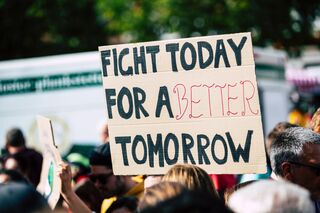Harm Reduction
Harm Reduction Is Not About Messaging
Why "harm reduction" messages for gatherings may miss the mark.
Posted December 13, 2020

Today’s post will be slightly different—related to drug policy, but also not. It’s about harm reduction and how the term has been applied to how we deal with the coronavirus. To begin with, harm reduction is an approach to health that acknowledges that abstinence does not always work; instead we should give people resources and messages that allow them to reduce the risk involved with things like drug use or sexual activity. For drugs, harm reduction looks like giving people new needles to use so that they don’t share or reuse needles—reducing the risk of contracting a blood-borne disease. It looks like providing people test strips to test their drugs, naloxone, and telling them to go slow or not use alone. It looks like opening supervised consumption sites so that people can use drugs in a safe environment.
Lately, there have been articles published urging us to adopt a harm reduction approach as opposed to purely encouraging people to stay home during the holidays. Give people tips as to how they can minimize risk since people will gather with families over the holidays anyways, since social interactions are incredibly important for us as a species. While I agree with the general ethos of not shaming people because it isn't productive and believe the authors of such articles have noble intentions, I don’t agree with the characterization of such an approach as “harm reduction.” The coronavirus pandemic is an airborne virus that isn’t completely analogous to drug use, or HIV.
To begin with, harm reduction has always been about prioritizing the needs of the most marginalized. While millions of people in this country gathered over Thanksgiving, there were also millions who were working retail and service jobs, meatpacking jobs, as farm workers, or in factories and warehouses; where they are potentially exposed to the virus. Others find themselves in cramped and overcrowded housing, where there is nowhere to distance if someone gets the virus. Yet, our harm reduction guides and messages have not focused on these people. Instead, we have focused on how to do leisure activities safely, how to meet with friends and families, etc. Comparably, there has been little to no guidance about how people forced to be exposed to the virus (at work and at home) can take steps to mitigate their risks; in part, because the structural conditions make it difficult to do so.
It is important to remember that harm reduction isn’t just about messaging, it's about providing people with resources. In the world of drug use, people are provided with new needles, they are given test strips to test drugs, they are connected to housing and healthcare supports, etc. When we focus our messages on gatherings, we neglect this crucial element of harm reduction. This past summer, groups like Project South and Dream Defenders operated free COVID-19 testing for a few weeks. In Canada, where I’m from, Justicia for Migrant Workers—a group of organizers in Southwestern Ontario that work with migrant farmworkers, visited farms and provided farmworkers with food, masks, and sanitizer. In cities across America, people have been delivering groceries and supplies for the elderly and other people at risk.
This isn’t to suggest that people who work essential jobs aren’t gathering with families at all—just that we are taking the wrong approach.
When it comes to reducing harm; harm reduction emphasizes approaches we know reduce harm. We know that having someone else nearby who can use naloxone can reduce overdose death. We know that the presence of syringe exchanges can decrease the spread of HIV and HepC. With gathering, however, we truly cannot say if the tips we are providing are indeed quantifiably reducing harm. We know masks reduce transmission, we know that opening windows increases airflow, which reduces risk—but we haven’t really studied these dynamics in the home where people gather. But we know that we are likely to let our guard down when we are with friends and family. On the testing front, prior to Thanksgiving, tons of Americans lined up to get tests to be cleared to travel and gather—but a negative test result doesn’t necessarily mean you aren’t infected at the time. Weeks after the holiday, the data is in—Thanksgiving has caused a surge upon a surge.
You might say that OK, well, why not both? Why don’t we encourage harm reduction for those exposed at work and at home, and for those gathering? However, these things are not separate from each other. Take the instance of a wedding that occurred in Maine—55 people gathering led to 177 cases and 7 deaths; 38 cases and six deaths were at a long-term care facility and 82 cases were at a correctional facility. When the virus spreads at a wedding, people take it to their workplaces, to their homes and they can expose others at their workplaces when they go to shop, for instance. This is how one gathering can lead to cases at a prison—where people have limited options to distance and protect themselves.
If someone asked me if they should gather with people outside of their household for the holidays, I would tell them an emphatic no. I would especially say no if this involved travel across the country. However, we don’t have to adopt an “all or nothing” approach. People do indeed need social contact and rather than giving tips about how to reduce risk in an unsafe environment, we can instead suggest safe alternatives. We can tell people to meet folks outside, wearing masks and staying apart. Go for walks with friends or visit the park if you can. In colder climates, cities should open up gymnasiums and large indoor facilities with good ventilation where capacity can be limited to allow for these social gatherings. And of course, we should condemn actions that do not make sense—like closing parks and playgrounds.
When we consistently insist that we cannot shame people for gathering, we may be inadvertently erasing or minimizing the pain of those who have gotten sick or lost loved ones to this pandemic. Close to 300,000 people have died and many of them alone; early on in the pandemic, some even had to be buried alone. Of course those who have lost loved ones will be mad when they see others gathering. It is not enough to insist that people do not shame others for the sake of public health—there needs to be a more sensitive and convincing argument. Harm reduction after all, comes from a place of pain itself—thousands lost to overdose, thousands lost to AIDS. These deaths fueled protests and rage against policymakers who were and are turning their backs on the dying. Shame is counterproductive but we can talk to people about it in a better way. We can acknowledge the pain, hurt, and anger and say that’s understandable that they may want to direct it towards those who seem to be ignoring guidelines. The anger shouldn’t be suppressed but channeled; rather than directing it others, redirect the anger above.
This touches upon my last point: harm reduction has always been about targeting the state for its negligence. ACT UP in the '80s and '90s had die-ins, had protests at the NIH, and wrote letters that could be characterized as “rude"—all to protest the fact that government negligence was killing people living with HIV. Today, the federal government refuses to provide people with money to stay home, refuses to cancel rent, refuses to enact worker protections and expand hazard pay and sick leave—all the while letting the virus spread throughout the population and kill thousands. They keep things open, yet tell people not to go out and refuse to give people the support they are crying out for.
I think we need more harm reduction in our approach to the pandemic, not less; but only if it centers the most impacted, holds people’s pain and grief, and targets the state with protest. Anything else is a misunderstanding of the term.




